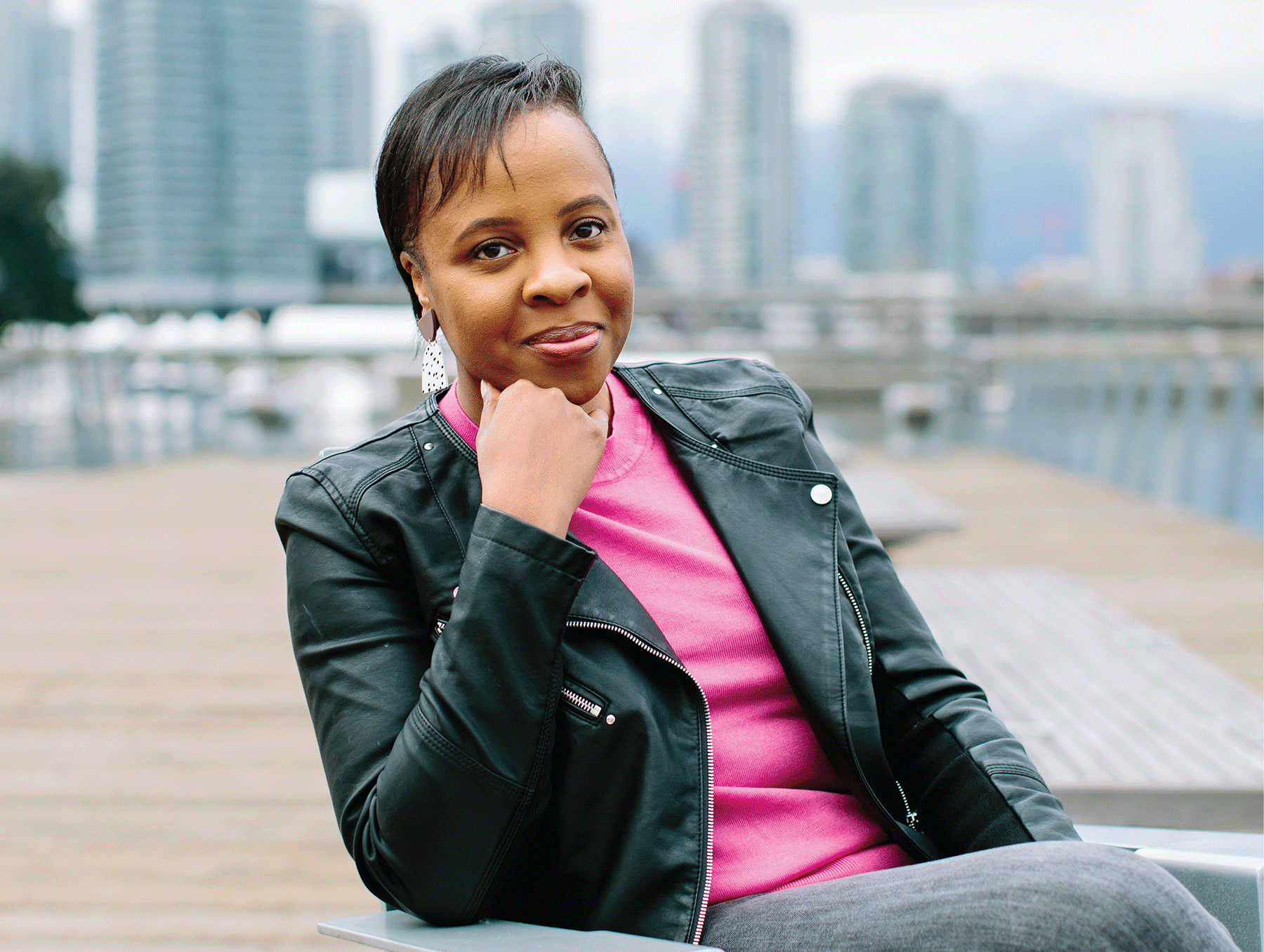“I always lean on the side of optimism.”
Nadia Stewart has never been to a protest in her life.
It’s November 2020 when we first speak. That spring, in the midst of a global pandemic, a video of a police officer killing a Black man in Minneapolis went viral. And an already anxious and exhausted world went over the edge.
When I ask Stewart about the protests and about the millions marching in the streets demanding racial justice in the name of George Floyd, she lets out a long sigh. Her shoulders slump and her eyes flicker with frustration.
She isn’t one for marching in the streets, but make no mistake: Stewart is protesting every day of her life. As the executive director of the Canadian Association of Black Journalists (CABJ), her entire career is a protest.
“Just because I’m Black, and just because I believe that Black Lives Matter…it’s just not my personality,” she says, explaining why she’s never attended an in-person protest. “It’s not me. I’m very much an introvert.”
I ask her if this is something she gets questioned about a lot. To my surprise, her answer is no. “I’ll be honest,” she says. “Black people don’t ask me these questions.”
Stewart leads the organization now, but the CABJ has been working toward its goals for decades. In 1996, a group of Toronto-based Black journalists established the CABJ with the intention of bringing together Black journalists to increase representation in the media and to celebrate one another’s work. Their efforts were far-reaching, involving advocacy, mentorship, and community building, and, until recently, were fairly quiet. Then events of this past summer changed everything.
Suddenly, organizations that had previously not been paying attention took an interest in the CABJ as it was suddenly at the centre of a global conversation about systemic racism. Stewart says offers to donate money or support programming began to pour in. So did inquiries from industry veterans working for major organizations like CBC, The Globe and Mail, and CTV. Where getting much-needed attention was once like pulling teeth, the same people were now listening with open ears. It was the moment that Stewart—and all of her predecessors—had been waiting for.
It’s 2010. A young Nadia Stewart, four years out of J-school, is walking to CBC in St. John’s, N.L., where she works as an on-air reporter. She’s doing what she set out to do, in a role she’s been comfortable with since before most journalism students can say Fourth Estate.
Two girls, both white, are walking several feet in front of her, but she’s lost in thought about the day ahead, not really paying attention. Until something happens that’s impossible to ignore: one of the girls turns around, looks at her, looks back to her friend, and says, “Look, there’s a….”
And then she uses a word that Stewart has heard, of course, but never aimed at her. Never back at J-school, never in any newsroom, and certainly never in her warm, loving community back in Toronto.
The girl’s friend looks panicked. She says, “No, you can’t say that!”
“I don’t care. I call them all—.” The word again.
The girls never speak to Stewart directly, never acknowledge her existence or humanity or that she’s an actual person who can hear them. Stewart doesn’t acknowledge them either. She walks on, makes her way to work, maintaining the semblance of its being just another day. But something fundamental has shifted in her—and one thought keeps ringing in her head: I’m going to need some help.
The latest incarnation of the CABJ is the result of Stewart’s own initiative. When she reached out to the group via email after her experience in St. John’s, she found that the association had gone mostly dormant. Stewart was shaken—and more aware than ever of her place in the world, and in the industry. “I was always one of the few,” she says.
When she started working to revive the CABJ in 2016, Stewart did so with a vision of an organization that could work on a national level. Stewart herself works in Vancouver, but the current (entirely volunteer) executive team includes a Western director, Julie Sobowale, who’s in Saskatchewan; an Atlantic director, Brian Daly, in Halifax; and Dexter Brown, the social media manager, from Toronto. Stewart figured that the only way to increase Black representation in the media was to support Black journalists in as many places as possible.
In terms of media diversity, Canada’s numbers are abysmal at best, and intentionally nonexistent at worst. The American Society of News Editors has been conducting an annual newsroom diversity survey since 1978; in 2018, it found that only 22.6 percent of employees at major media organizations in the U.S. were people of colour. Similarly, a 2018 Pew Research Center analysis found that 77 percent of U.S. newsroom employees (including reporters, editors, photographers, and videographers) are white.
In 2016, Canadaland reached out to 18 major newspapers across the country in search of demographic data. J-Source tried a similar tack in both 2014 and 2017. In both cases, participation was lacking. Many major organizations—including the Globe, the National Post, and the Toronto Sun—either failed to respond to the requests at all or failed to fill out surveys sent to them. In 2019, Ryerson School of Journalism assistant professor—and instructor of the course that publishes this magazine—Sonya Fatah, associate professor Asmaa Malik, and researcher Davide Mastracci tracked the demographics of newspaper columnists in three leading national Canadian publications (The Globe and Mail, the Toronto Star, and the National Post) and found that, over the last 30 years, white columnists have become even more overrepresented in comparison to the changing demographics of the country. The CABJ’s own research has identified a total of four Black managers—in the entire Canadian journalism industry.
CBC, as a public broadcaster, is the only journalistic institution in the country that’s federally mandated to publish its national demographic data. In 2020, it reported that 14.6 percent of its staff identify as a visible minority—compared to 22.3 percent of Canadians, as reported by Statistics Canada in 2016. The CBC report digs no further into which visible minorities are represented. That means there’s no way of knowing how many Black reporters, editors, photographers, or producers are employed by the corporation.
“So that’s why the Canadian Association of Black Journalists is so important. It’s letting other Black journalists know, letting the industry know, that collectively, as a voice, we want to ensure Black journalists are heard”
When Stewart felt as if she was always one of the few, she was right. By pursuing a career in TV journalism, she was choosing to be visible in an industry where systemic barriers were everywhere. While she herself is lucky enough never to have been subjected to overt racism in a newsroom, she says Black journalists come to the CABJ all the time with stories about racist language, exclusion, and refusals to tell Black stories on the grounds that they “aren’t relatable.” Stewart and her colleagues do everything they can to support the people who ask them for help, whether by advocating for them, acting as a buffer so that their stories may be told while preserving their anonymity, or simply serving as a source of support and community. Through these experiences, Stewart has seen first-hand why organizations like the CABJ need to exist: to make people like her feel like they are not alone.
Stewart was born in 1983, the second of three sisters. She grew up in the Greater Toronto Area, bouncing between Brampton, Mississauga, and Toronto. For the most part, she didn’t have to grapple with the racist underbelly of Canada because she lived in its most diverse locales and because her parents made a great effort to shield her and her sisters from these issues. “I had a diverse circle of friends. I had my four Black girlfriends. And, you know, we all grew up in Toronto, we look like each other, we sound like each other,” she says. “I just didn’t encounter those experiences. I think my parents went out of their way to shield us from those experiences.”
Stewart loved watching Connie Chung on ABC’s 20/20 with her mom. She already had an interest in public speaking and she liked the idea of being on camera—following in the footsteps of women like Chung and CTV’s Andria Case, then one of the few Black female anchors. When it came time to choose a path after high school, her parents encouraged her to pursue journalism; it was a natural fit.
During a high school co-op placement, her supervisor told her that students from Ryerson often seemed too prideful, relying too much on the school’s reputation and not enough on their talent. “I think I was really impressionable at that time, so when she said that to me, it made me think, okay, well, I don’t want people to think that of me,” Stewart says. So she declined her Ryerson acceptance and chose an unknown entity: the University of Guelph-Humber’s brand-new journalism program. She would go on to become a member of the first ever-graduating class, with a degree in media studies. “I wanted to prove that you didn’t have to go to one of the top schools to be successful, or to end up building your dream, or to go where you wanted to go.”
It didn’t take her long to prove it. Her stint at CBC in Newfoundland, which started as a short-term position, turned into two and a half years. After that, she moved to Calgary to work as a CBC multi-platform reporter and anchor. In 2014, she took a job at Global News in Vancouver as a video journalist, a role that requires reporters to script, shoot, and edit their own segments for live TV.
Successful as she has been, Stewart says that she doesn’t think that had much to do with school. She skipped a lot of classes—not because she was lazy, but because she was working. By her second year, she was doing on-air reporting and fill-in anchoring for Rogers TV Peel. “They started out as volunteer opportunities. It definitely did not start out as a paid job,” she says. “And then, just through hard work and God-given talents, they recognized that I was someone who had potential and they started to shuffle me into certain opportunities.” By her fifth and final year, she was hosting her own call-in talk show and holding down a volunteer position as a regular weekend anchor on the network.
It’s September 2020. Following the summer’s protests, the flurry of inquiries that began arriving from newsrooms across the country has turned into actual meetings. One morning, Stewart and her carefully curated CABJ team are on a Zoom call with executives from a major Canadian legacy news organization—one whose name you would recognize.
Since the events of this past summer, meetings like this one have been frequent and often frustrating. Smaller, independent newsrooms want to take action; legacy newsrooms want good optics.
Stewart diligently takes notes, trying to figure out what, exactly, these people are asking of her. Their language is broad—as if they know they’re supposed to be doing something, but can’t quite fathom what that might be. As the executives, none of whom are Black, continue to explain their nebulous goals, mentioning something about “addressing issues related to BIPOC journalists,” Stewart finally decides she can’t just sit there listening. “What about those issues?”
A pause.
“Well,” says one executive, looking sheepish, “we haven’t thought of that quite yet.”
According to Stewart’s colleagues, she doesn’t shy away from pointed questions or confrontation. She gets specific: What are you going to do when you hire more Black newsroom managers? How are you going to follow up and make sure that this is an inclusive environment? What are you going to do to make these new hires feel safe and seen? In Stewart’s experience, the executives and editors she works with rarely have the answers.
That’s how the CABJ x Canadian Journalists of Colour (CJOC) Calls to Action came to be. Stewart and Anita Li, co-founder of the CJOC, knew the industry needed a road map if it was going to change. Li—who stepped down from her role in the organization in February of this year—and her co-founder Sadiya Ansari started the CJOC in 2018 after reading a Medium post by journalist Sunny Dhillon about the microaggressions he faced working at the Globe’s Vancouver bureau. Although they had discussed the idea of the CJOC prior to Dhillon’s article, the post confirmed that this conversation was in desperate need of a platform. Now, CJOC has over 1,000 members, with chapters in Vancouver, Winnipeg, Toronto, and Montreal.
In fall of 2019, the pre-election media was overtaken by resurfaced photos of Prime Minister Justin Trudeau in blackface and a (since-deleted) Vancouver Sun op-ed by a Mount Royal University instructor that argued that multiculturalism is bad for Canada. Li saw another opportunity to ride the conversational wave while people were paying attention. She reached out to Stewart on Facebook and they began to talk about what a call to action might look like. “I’ve grown to respect her a lot as a leader,” says Li. “And also the way she’s able to not only rally her team, but also in the way she’s managed conversations with media executives around equity. And these are media executives at major institutions across the country, including places like the Star, CBC, the Globe….It’s really important to me to work with somebody who has the knowledge and the leadership and the groundedness and the emotional intelligence to be able to do the work. Because it’s not always easy.”
The Calls to Action were released in January of 2020. Stewart and Li distilled the missions of their two organizations down to seven not-so-simple steps, covering everything from reporting on and diversifying newsroom demographics, consulting with racialized communities, and developing mentorship and educational opportunities. Their endeavour would prove prophetic; Li and Stewart thought race was topical when they were writing the document over the summer of 2019, but they had no idea what the next year had in store. “The feeling we had that we were onto something back in December 2019 was totally confirmed seven months later,” says Stewart. “We started to see that, yes, this was really needed.”
But Stewart also acknowledges that the Calls to Action themselves weren’t exactly revolutionary. “These are things that journalists of colour have been talking about for years. They’ve been calling for these kinds of changes. But nobody was paying attention,” she says. “But never before had there been these two organizations that existed side-by-side in the industry, raising their voices collectively, around these issues that everyone knew were a problem.”
Although BIPOC journalists were speaking up, some organizations in the industry weren’t listening. While publications like The Discourse, The Narwhal, and The Sprawl were quick to publicly endorse the calls, legacy media were much slower on the uptake—major organizations like CTV and CBC have yet to endorse the Calls to Action. Stewart’s own employer, Global News, hasn’t ratified the Calls to Action, but Global-Halifax did sponsor a scholarship through the University of King’s College journalism school for students in CABJ’s high school mentorship program, J-School Noire.
Although the issue could be frustrating for some, Stewart remained resolute. When things do get tough, she turns to her faith (she is a devout Christian), her family and friends, and her husband. With her community supporting her, she forges on. “If this work feels so burdensome that I can’t keep on going, then I should probably stop,” she says. “But it doesn’t feel that way. Yes, the conversations are tough, but I always lean on the side of optimism.”
The most fulfilling part of her work is seeing the impact that true representation can have. “I’m not just here reporting, I’m not just here for the sake of it. This does mean something to me,” she says. “So, I think that’s why the work of the CABJ is so important. It’s letting other Black journalists know, letting the industry know, that collectively, as a voice, we want to ensure that Black journalists are heard, because at the end of the day, the only thing that all of us want is change.”
Part of what makes Stewart an effective leader is that, despite her capacity for directness and her drive, and that she essentially works two emotionally demanding full-time jobs (one entirely without pay), she isn’t an intimidating or confrontational person. In her personal and professional lives, she conducts herself with quiet grace.
“I suppose the thing that stands out to me more than anything about Nadia’s leadership style is the reflective approach that she takes,” says Brian Daly, the CABJ’s Atlantic director. He attended the foundational meeting of CABJ, which took place on Ryerson’s campus while he was still a student in the 1990s. Stewart approached him directly to join her team when she resurrected the group. “There’s no rushing into decisions. There’s no rash decision-making. She has an analytical mind. And she understands that when you rush to decisions and when you lead with your emotions first, that doesn’t work.”
“Sometimes you really just need a mentor to tell you, yeah, you can do it. Sometimes you just need that one person to tell you that. And especially for Black journalists, they’re not hearing that enough in their newsrooms”
This subtle, analytical approach to decision-making is the defining feature of Stewart’s work as a video journalist at Global. John Hua, Stewart’s long-time colleague and friend, says, “A lot of people gravitate toward Nadia just because of the way she is. She’s a very calm person. She’s a natural leader.” She leads without arrogance, Hua says, a rarity in broadcast news. “In the news business, especially in the TV journalism business, there’s a lot of personality. There’s a lot of ego, sometimes. And I would say Nadia is the antithesis of that….It’s not about competition. It’s about helping the team, it’s about helping older colleagues, it’s about being there for her friends.”
Daly believes that’s what makes Stewart so good at her job as the leader of their team. She plays to her strengths. He points to the 2020 Black Lives Matter protests as an example of why. “I just marvel at the skill set of people who are in the protest movement, and rally a crowd, keep the crowd engaged, keep the crowd peaceful. But Nadia recognizes that our organization doesn’t need to be stepping over some of the protest leaders leading rallies and marches to deal with the problems that we have in media,” he says. “Our approach needs to be on the collaborative side. Working with news organizations where necessary, calling them out where necessary. She has made sure we’re focused on areas where we can make the most impact. If we were trying to organize rallies, I don’t know that we’d be as effective. But when we are speaking the truth to powerful news organizations in this country and seeing incremental results, that makes it clear to me that that strategic approach to leadership works.”
For now, Stewart has chosen to focus the CABJ’s efforts on raising up a new generation of Black journalists. Most of the organization’s programming is for young people: high school or university students who are still deciding what they want to do with their lives. “We have been hearing quite regularly that a lot of people just want to connect with other Black people in this industry,” says Stewart. In her opinion, those connections should start well before they start their careers.
In February of 2020, the CABJ launched a pilot program in Halifax called J-School Noire, which introduced Black high school students to the field of journalism. Participants conducted interviews, anchored newscasts, and met a variety of Black Canadian journalists, including Portia Clark, host of CBC Radio’s Information Morning in Nova Scotia, former Sportsnet reporter Vince Williams, and Trent McClellan of This Hour Has 22 Minutes. In 2021, the program was run once again in Halifax, Ottawa, Edmonton, and Toronto. “Sometimes you really just need a mentor to tell you, yeah, you can do it. Sometimes you just need that one person to tell you that,” says Stewart. “And especially for Black journalists, they’re not hearing that enough in their newsrooms. They’re not getting that support and that positive reinforcement from their leaders. And so, if we can be the organization that comes behind them and says, ‘Yes, yes, you can do this,’ then I think we’ve served our purpose.”
At the end of one of our interviews last fall, I ask Stewart to tell me about an experience that made her feel as if her work is worthwhile, that made her feel proud. As she often does, she takes several moments to reply, carefully considering her most effective way forward.
The story she chooses is a simple one. A student who participated in the J-School Noire pilot project last year emailed the CABJ to tell the group that, despite having previously been dead-set on going to law school, she had decided to go into journalism. Because of their program.
“That’s what it’s about,” says Stewart. “It’s really about inspiring them, awakening dreams that might have been dead because they don’t see themselves represented, or doors were shut in their face. If we’re here helping them and supporting them and, at the end, they can look at this and say, okay, actually, I can do this because the CABJ is here, because there’s this support, because there’s this organization that believes in me, okay, I can do this. And then they actually make a go of it. To me, that’s what this work is all about.”




